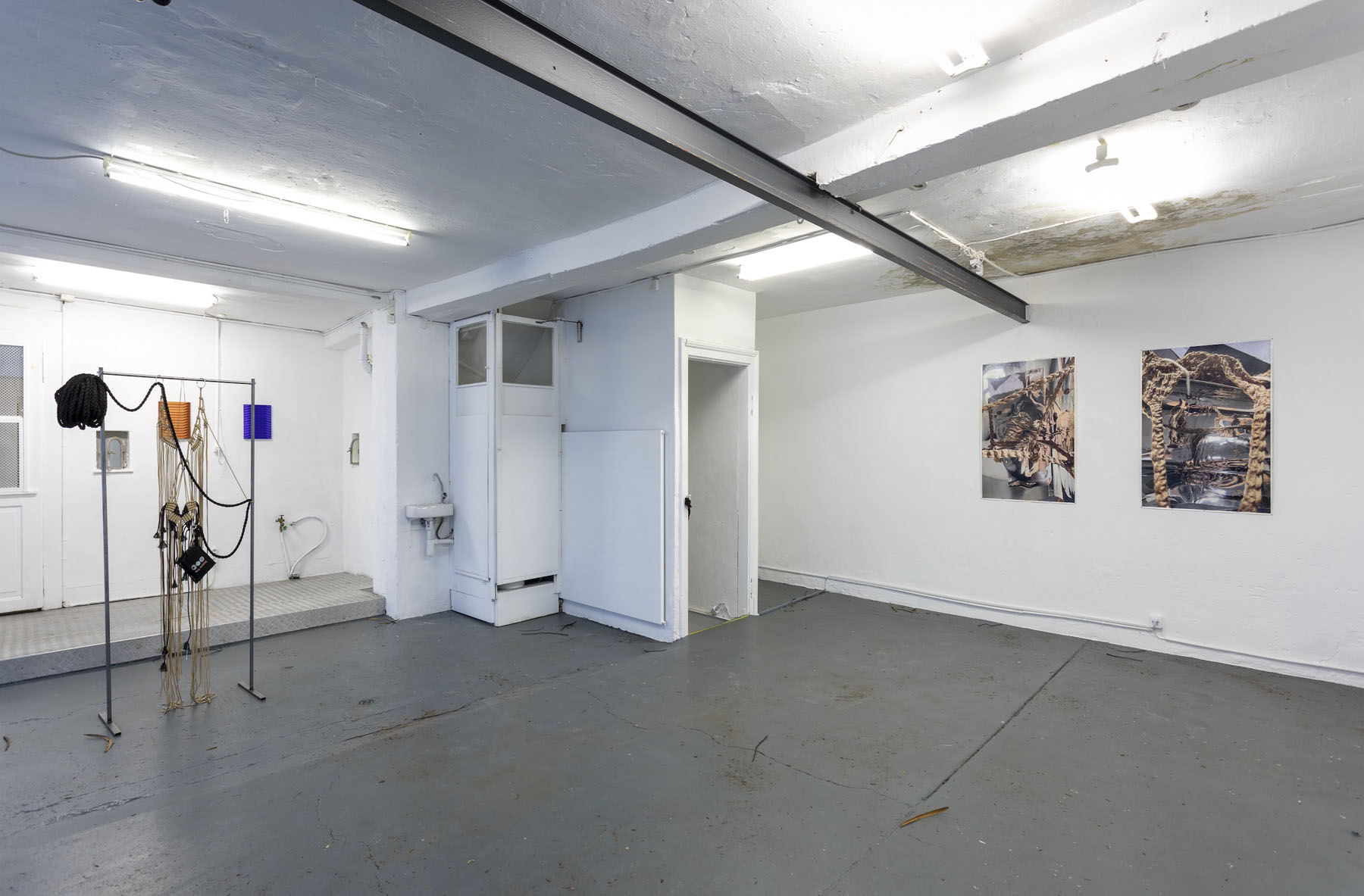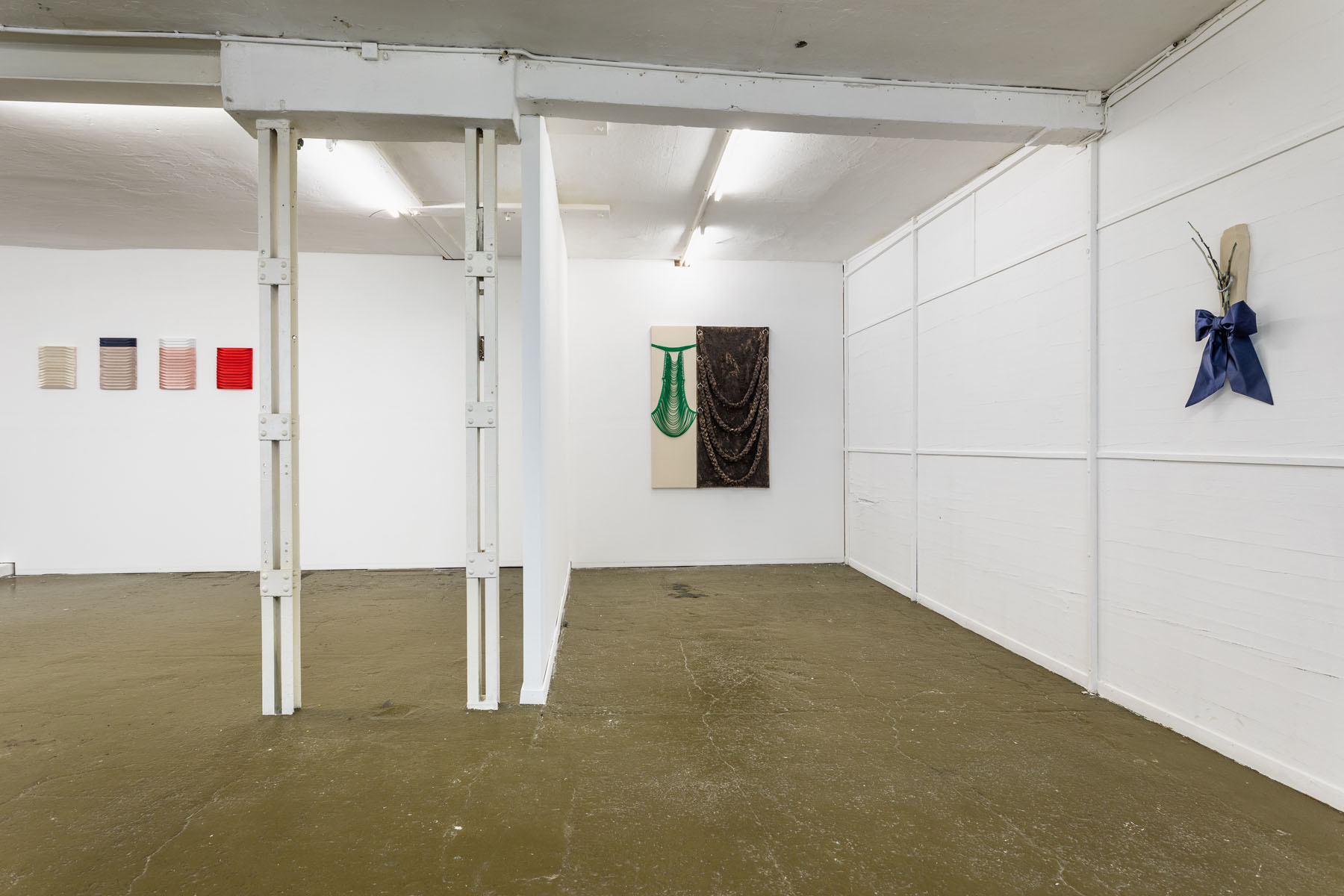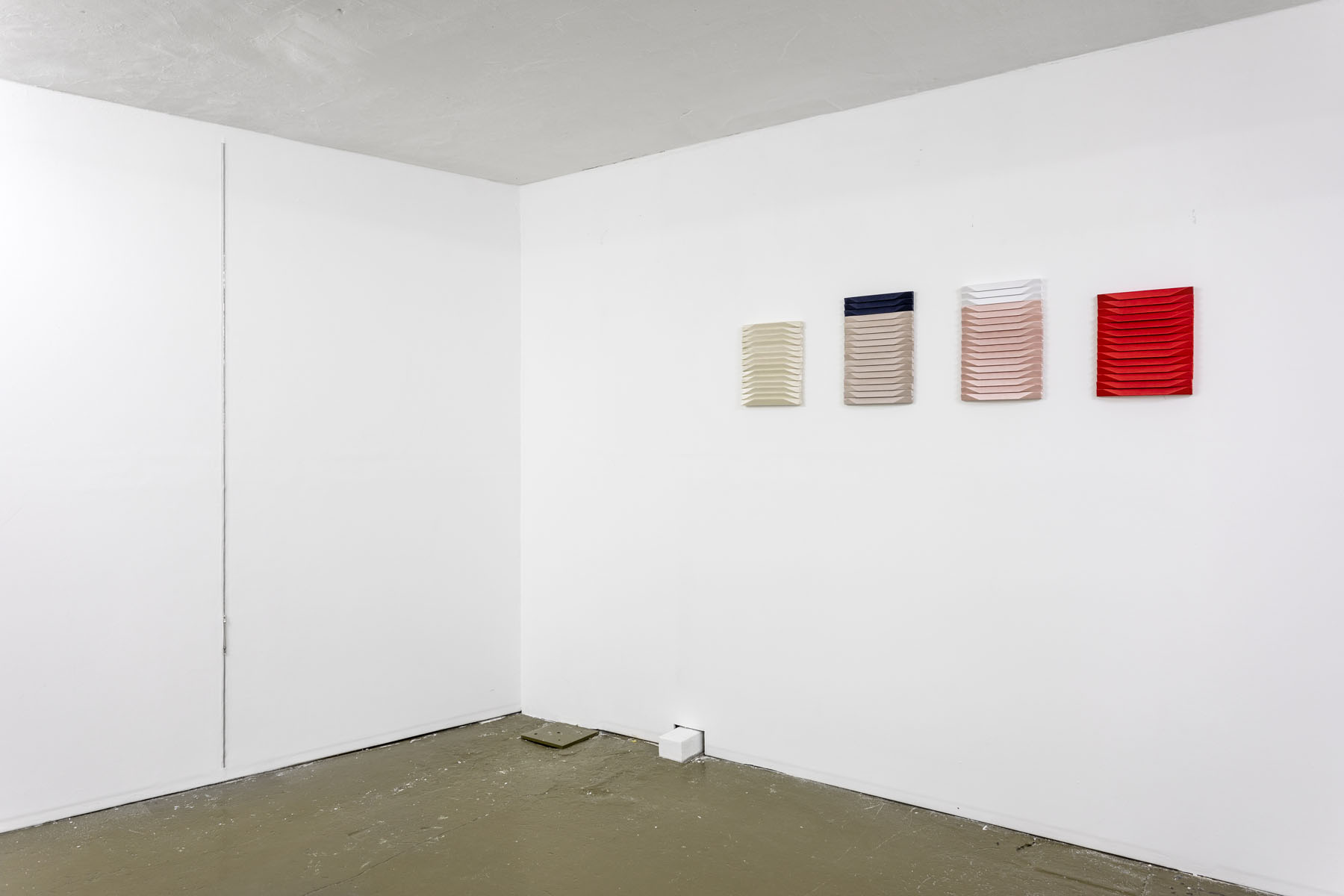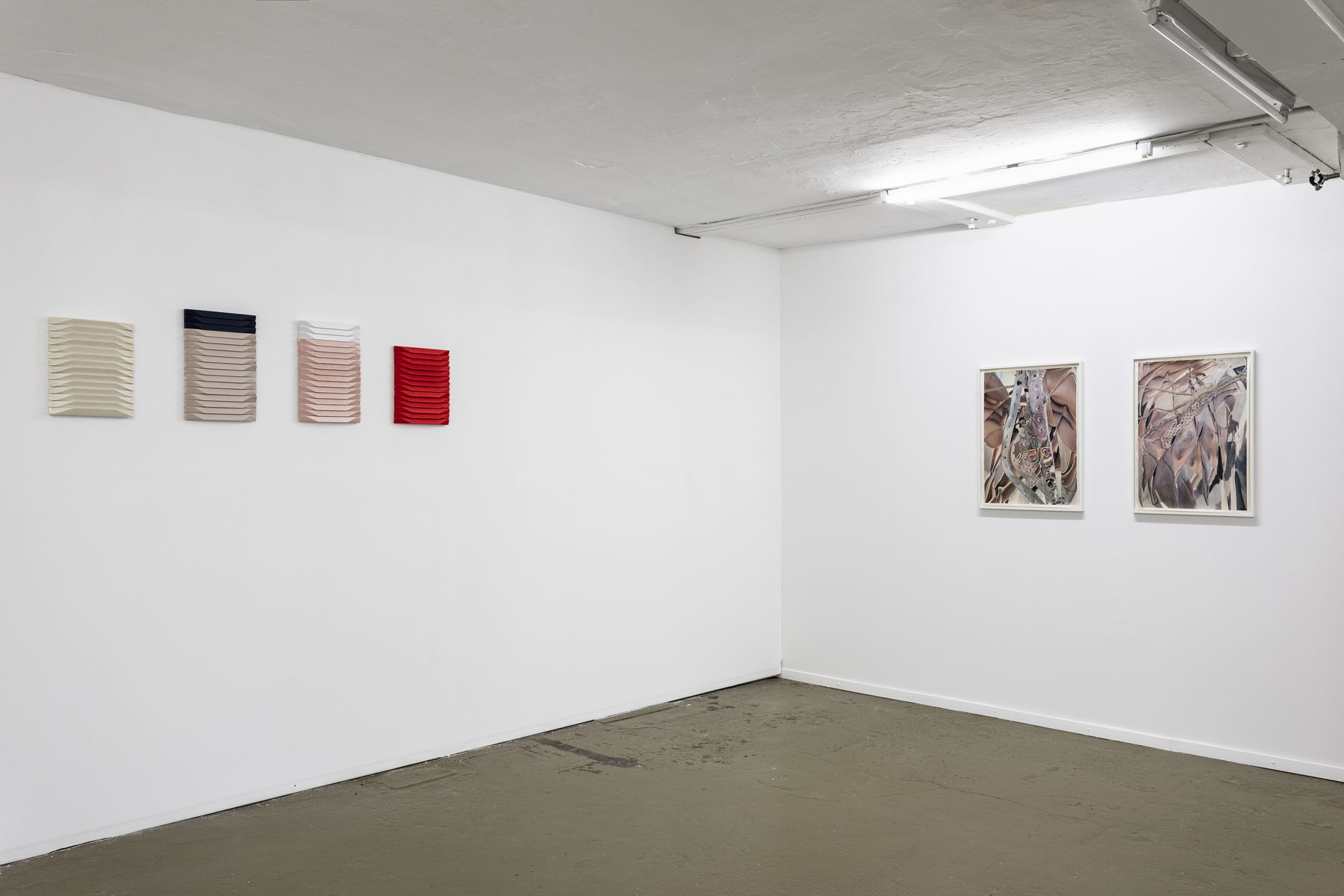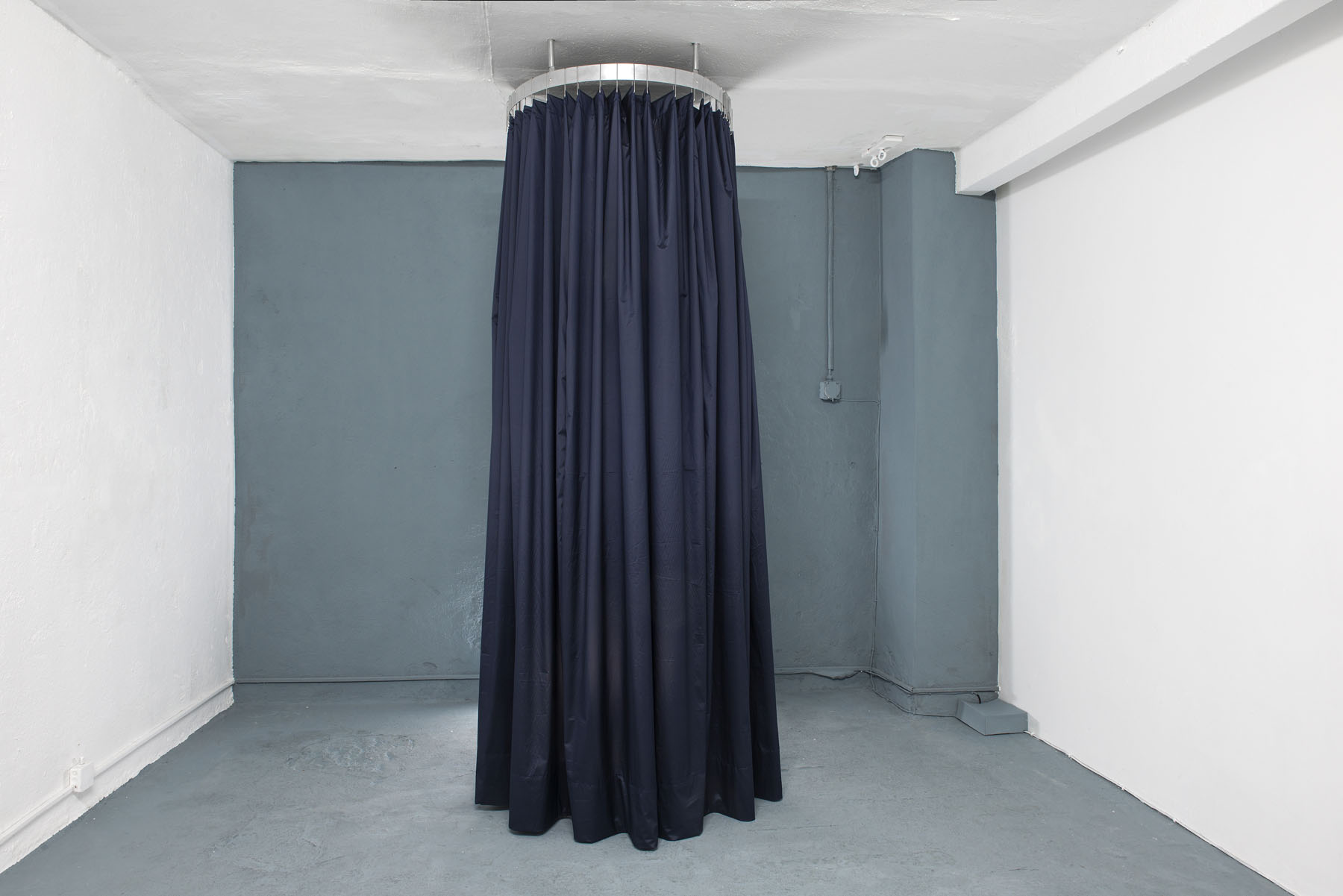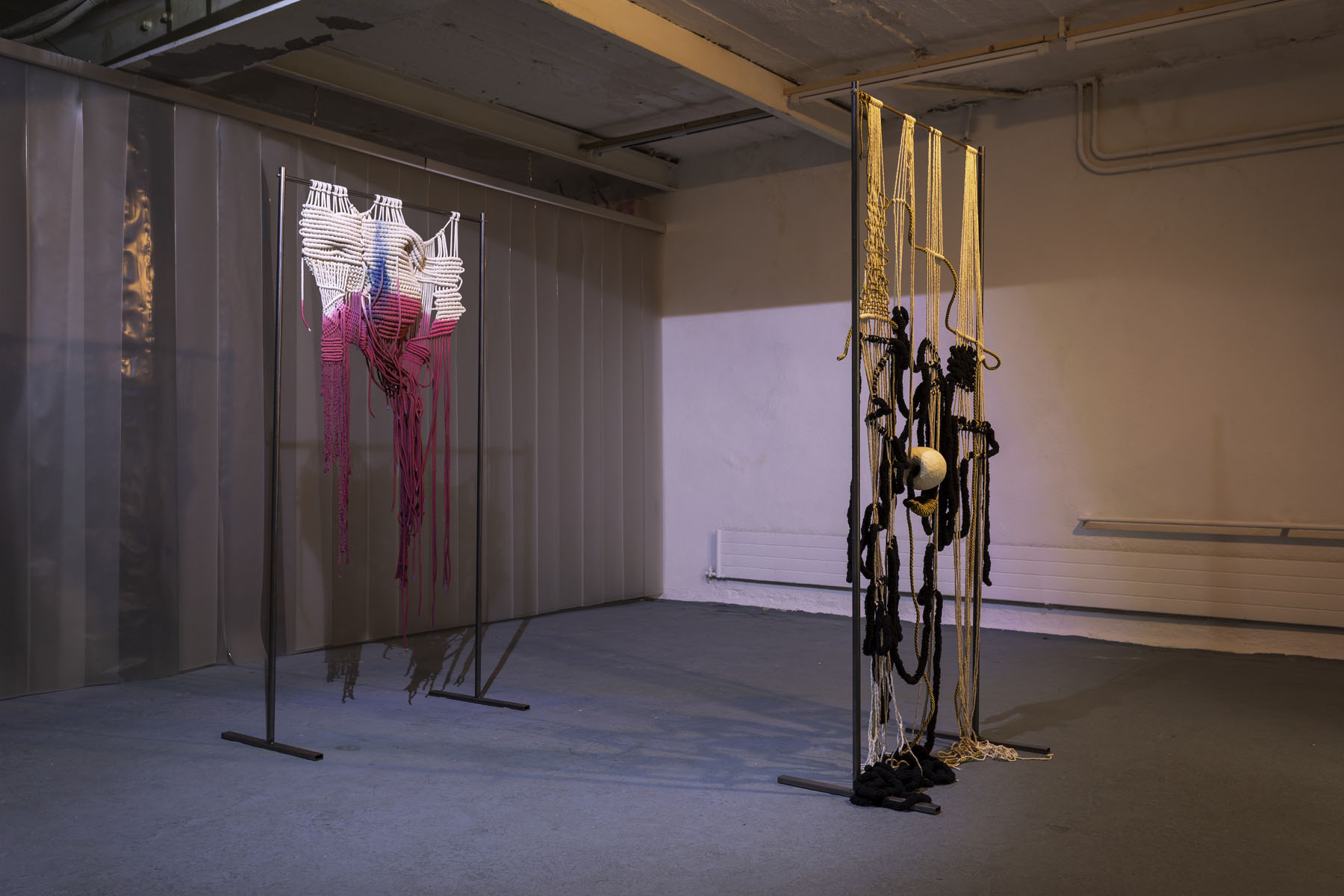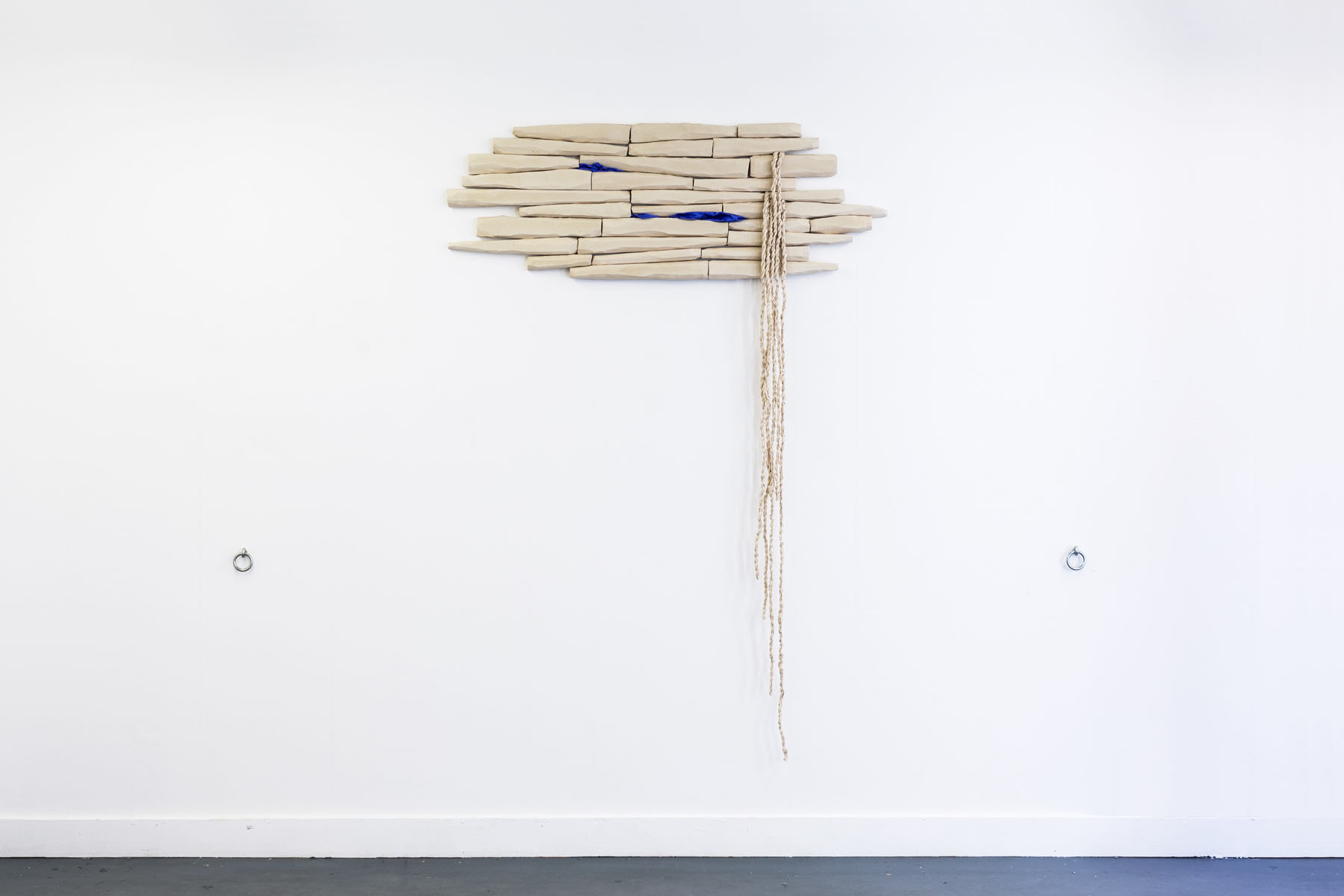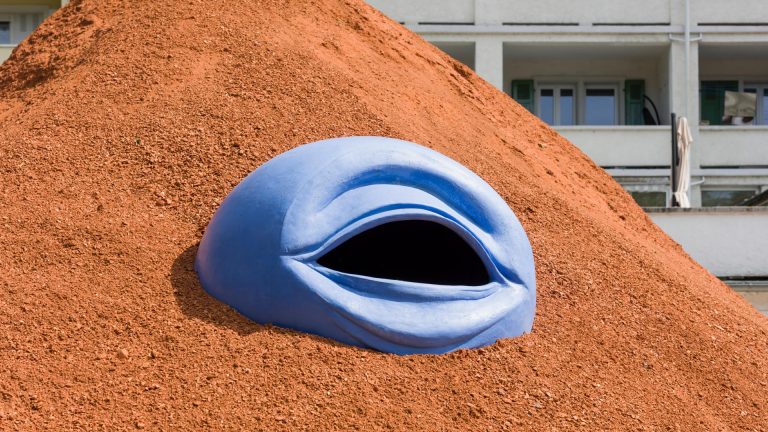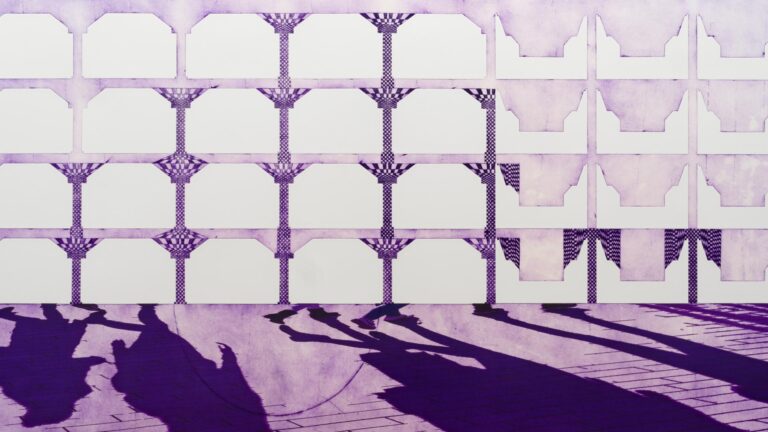Artists: Lisa Biedlingmaier, Roman Gysin, Manon Wertenbroek
Exhibition title: Heavy Satin
Venue: Last Tango, Zurich, Switzerland
Date: January 24 – March 14, 2020
Photography: all images copyright and courtesy of the artists and Last Tango, Zurich
Heavy Satin is an exhibition that aims to explore the potential of ambiguity, be it through the de-pola-rizing of stereotypes or by testing escapist strategies. The title seeks to conjure thoughts of an impen-ding weight, subtly suggestive of the aggression and machismo of Heavy Metal yet also evoking the voluptuous feminine sensuality of satin.
In Heavy Satin categorical divisions between systems such as decoration vs. fine arts, tastefulness vs. vulgarity, masculinity vs. femininity, artifice vs. reality are challenged. Perspectival shifts in hanging are to be experienced throughout. Roman Gysin‘s wall sculptures are placed at variable heights. Lisa Biedlingmaier‘s work can be seen from various angles and their see-throughness creates a layered view. Manon Wertenbroek‘s Zippers alters our interaction with the wall as the classical support struc-ture.
In 2013 the curator Uta Ruhkamp wrote in Textile Turning-Point: “While Arts-and-Crafts in the 21st century was a reaction to industrialized mass production, it now seems to be the digital age in the 21st century that motivates a shift towards working by hand and textile materials.” Currently it seems there is an interest in hybridity, combining traditionally linked mediums of feminist defiance art such as crochet and embroidery with different materials and techniques be it carpentry or digital image manipu-lating.
The artists delve into the complexity of archetypal figures such as the witch or clown (contrasexuality), masquerade as an empowering device or the valorizing of aesthetic canons that have been pejora-tively connoted, be it romanticism or the kitsch. There is an omnipresent sense of the crafting and so-metimes healing hand, with sculptures, painted photographs, and installations having tactile surfaces and textures such as satin, soil, rope, felt, zip, latex and tulle. We come to reminisce upon childhood with its magical memories of fantasy and role-play but also contrastingly to the adult world of BDSM with the fetishistic desire to touch, tie and tease.
Roman Gysin (born 1984 in Möhlin (Switzerland), lives and works in Zurich)
Gysin leads us into a world of riddles and “faux-play.” Decoration, the uncanny, the fetish, the everyday and unapparent are key to his art. There is something Goberesque in the trap doors and caricatured stone wall sculptures. Their affinity to Gober lies in the fact that they are “kind of camp-objects”: they are a bit too much, exaggerated, theatrical and at times effeminate. There is a truth and celebration to be found in sentimentality and the artifice, two things that have historically been often mocked. This labeling could be positively understood. As in Dominic Eichler‘s writings on Gober‘s practice: “This [too much] is in no way intended as a denigration of their impact, on the contrary, it is part of their unique quality… enhancing them.” However, Gysin‘s delicately manipulated sculptures at the same time also pertain to a minimalist vocabulary. There is a sense of introspection in the act of making: an endearing commitment to craft and detail, be it in the tailoring of satin or the custom-made shaped canvases. This illusion of the genuine is one that Gysin plays with. His sculptures and installations at times warp the real creating seductive impressions of girly soft ribbons and iridescent metal surfaces or the sense of coarseness with soil-covered ropes. There is an antithetical quality to his work: a genuine sincerity in the artificial and a desire to escape the everyday. Yet, it unravels all sorts of strangeness in the ordina-ry. Is the trapdoor a mystical entrance that leads to somewhere else? Or is it a prop?
Upon entering the exhibition space we come to to step on and into Gysin‘s work Floorspreadmixture No. 3 (2018). An artificial staging of litter and with its à la Felix Gonzales Torres gesture of participati-on, the visitor is able to walk amidst scattered bark dust, bean pods, painted branches, leaves, jewelry fragments They are poetic meditations on outside/inside and public/private space. Yet this litter is a special one. It is a simulated situation. The jewelry is reminiscent of the pickings of magpies with their urge to steal sparkly things for their nests. Chantal Küng remarks that Gysin “plays with the wishes of the viewer; who hasn‘t hoped to find something incredibly valuable… but the act of really picking so-mething up from the ground inevitably brings with it a strange kind of shame; a desire, an unattributab-le hope, is revealed, that becomes public, and not only this; the moment of value attribution, the decisi-on about „valuable“ versus „waste“ becomes visible.”
Floorspreadmixture No. 3 is also reflective of a personal routine: Gysin takes pleasure in taking breaks from working and strolling around the suburban neighborhood of his studio in Schwerzenbach. A place with pockets of nature yet still urban. Perhaps Gysin has a feeling of “urban ambivalence” idealizing the suburb as being in-between countryside and the city (Beauregard, 2006). Suburbia is home to laid-back vibes with shopping centers, fast food restaurants and gardens, but also holds the desire in keeping up with appearances. Guillaume Guilherme notes the following: “Roman Gysin is not focused on luxury, for example; rather he is moved and fascinated by the efforts that people of lower economic classes invest in decorating their spaces. This is not a position of Art’s superiority over the aesthetic environment of lower classes; rather, it is a looking into the widespread human reflex to appropriate space, to personalize, or domesticate, one’s interior.” Gysin‘s value attribution brings to mind Robert Smithson‘s alternative and positive perspective on the suburban ruin that is evident in his ground-brea-king 1967 article The Monuments of Passaic. A rusty sign is turned into a monument, the suburban landscape becomes a site that is already in decay before it starts to physically crumble.
Gysin‘s Welcome Home (2018), Hanging Out with Strangers 6 (2020) and Upper Westside (2016) are sculptures made up of textured volumetric blocks that are irregularly assembled forming a stone-like wall. Their making involves a laborious process of chipping wood with a special forestry tool called a bill hook. The individual pieces are covered in canvas and treated with a glue-chalk or green earth mixture. Assembled together they hint at masonry, a fragment made up of twenty-some compartmen-talized parts. A hybrid of painting and sculpture there is something suggestive of postwar abstract shaped canvases of the 1960s.
Attached on the surface of Welcome Home is a red ribbon bow. The associative image of the ribbon bow goes far and beyond. One could think of a bourgeois young girl wearing a bow hair tie or lingerie fasteners with bows on a plump thigh. Apparently in the world of tattoos bow ties follow a symbolic color-coded system just like the hanky code employed usually among the gay male casual-sex seekers or BDSM practitioners. The origin of the ribbon bow comes from the love knot, whereupon the first love knots were thought to be tied by sailors and given to loved ones as signs of affection before leaving for the sea as the knot symbolized the entangling of lovers. In Hanging Out with Strangers 6 we see satin and ropes coming through the slits, a cheeky yet soft protrusion. The twisted ropes might make one think of Rapunzel‘s braid.
Satinbilder [Satin Images] (2019) are a series of satin panels with a minimalist and geometric abstract vocabulary. Playing with appeal of surface and three-dimensionality their sensuousness is in contrast with the orchestrated flatness of the vertebrae-like or ventillation-like structure. Gysin has been loo – king into the history of satin: “During the Middle Ages satin was reserved for the wealthy and stood for exclusivity. Today satin is a synthetic substance (synthetic fibres) though originally it was made from a natural raw material (silk).”
Lisa Biedlingmaier (born 1975 in Chelyabinsk (Russia), lives and works in Zurich)
Lisa Biedlingmaier‘s sculptural installations are part of her recent series I am Healer (2019-20) and are composed of steely structures, warming macramés and remedying textiles and objects. Her practice gravitates toward traditional handicraft and is informed by a wide-ranging milieu of feminist writings and healing practices. The history of macramé goes back to the Babylonians and Assyrians who used macramé-style knots as decoration. It seems that the word macramé is derived from the Arabic miqra-mah, believed to mean „ornamental fringe“ or „embroidered veil.“ This notion of unveiling is explored through a process of thinking and doing, passive and active dynamism, receiving and giving. The artist notes how each pattern “illustrates the connections and correlations that are made, that are formed and made manifest. (…) I therefore assign a broad spectrum of meaning to my macramé nodes. So-metimes they stand for tensions and trigger points, sometimes for traces, memories, opinions, concepts–on a physical, mental and spiritual level. Everything that forms and influences our existence.”
Upstairs are two sculptures depicting the figure of the witch. She notes: “These witches represent the repressed female energy in our collective unconsciousness. They stand for the widespread violence towards women through history, and we all carry them around in our emotional, mental and physical bodies.”
In Young Witch (2018) needles pinch through fleshy tan colored ropes. They may hint at acupuncture or the BDSM practices of piercing play. In 1792 Anna Goeldi from the Canton of Glarus and often nick-named “the last witch” was falsely accused of have of putting needles, through supernatural means, in children‘s food. A stylized and fragmented body Young Witch alludes to rebellion and sexual liberation. She “carries” a black cross-body pouch tied with safety pins. It is labeled with the words “Body Buil-ding” with the typeface “Heavy Metal.” She is an emancipated punk fighting entrenched social norms. She also “carries” a bundle of black ropes, whose (heavy) weight is both a physical but also a symbolic shouldering. She carries the symbolic burden of responsibility for the historical and current threat that women face: the witch hunt (Federici). Mirroring the 16th- and 17th-century Europe witch hunts, Fede-rici argues that the world is currently witnessing a new surge of violence against women. Similar to the dawn of capitalism, this new wave of violence against women is occurring alongside a new expansion of capitalism.
Biedlingmaier’s Old Witch (2018) seems to relate to Carol Hanish‘s 1969 paper “The personal is the political” or what Rozsika Parker defines as “the subversive stitch,” that is a reactionary stance toward a conservative anti-woman line. The sculpture contains a macramé illustrating the female reproducti-ve system that is slightly de-centered and partially covered by a floral cloth. With this non alignment, the artist is interested in the historical and materialistic analysis of female’s subjugation, reminding us of how the female reproductive system has become detached from female control and rather gover-ned by capitalist interest. Stones and other objet-trouvé are weaved and encapsulated in cocoon-like vessels in this towering yet delicate figure. There seems to be a resonance with Frederici‘s stance on womanhood: “Since the beginning of capitalism, women have fought to change what it means to be a woman. (…) I don‘t want to give up the category ‘woman.’ It is not a biological category, it‘s a socio political and historical category. If you cannot name your condition, then you can’t make certain kinds of struggle. When I think of ‘woman’ I place myself in a history and in particular forms of struggle that women across the world are continuing to this day.” (Silvia Federici in Mask Magazine, 2015)
Manon Wertenbroek (born 1991 in Lausanne, lives and works in Paris)
In Wertenbroek‘s new body of works of sculptures, painted photographs and installations she has been testing the lack of fixity and allowing for ideas to cross-pollinate within a single work, or cluster of works. Juxtaposing imagery from literary or psychoanalytical themes her costume-based works Witch (2019) and Clown (2019) are made up of latex casts of the artist’s face and skin. Like a snake chan-ging its skin, Wertenbroek performs a dress up, a form of embellishment as critique. They are allegori-cal faces, masks to whom the artist has been granting the power to defy expected social traits. In The Witch and the Clown: Two Archetypes of Human Sexuality Ann and Barry Ulanov note how “the arche – types of witch and clown are points of entry for the outlawed opposites within us, the archaic energies of sexuality and spirit.” Following the Jungian notion of “contrasexuality” the witch and clown can be understood as symbolic identities that represent a complex combination of traits and experiences of man and woman. Wertenbroek‘s Witch conveys sexual and irrepressible drive. She has a silver face with partially closed eyes make it seem as if she is rising, awakening from a lethargic trance-like hiber-nation.
A rainbow colored sequin tutu is placed as a collar supporting the heart-shaped mask of Wertenbroek‘s Clown. A long blond wig is set against a silver, star studded body suit. Relating to the world of emo-tions, the clown breaks down cultural imposed ego-boundaries. It plays with ambiguity. The clown has often been adopted as a symbol for the collapse of man as the achieving sex. The photographic self-portraits of Claude Cahun come to mind. Born Lucy Schwob, she changed her name into Claude Cahun in 1920 becoming one of the exponents of surrealist photography. Her work explored gender identity and the subconscious mind constantly pushing the boundary between masculinity and femi-ninity. She once said “Under this mask, another mask. I will never finish removing all these faces.”
If the eeriness of emptiness behind the mask is present, it is also the risk of what is hiding behind the costume. What is it? What is real or surreal? Pirandello’s Six Characters in Search of an Author (1921) addresses these issues concerning identity and its crisis. As the title denotes the play is about six abandoned characters in search of an author. Similar to Wertenbroek’s Clown and Witch they have no names and are defined only by their functions: Father, the Mother, the Step-Daughter, and so forth. As one of the character announces: “a character, sir, may always ask a man who he is. Because a cha-racter has really a life of his own, marked with his special characteristics; for which reason he is always ‘somebody.’ But a man—I’m not speaking of you now—may very well be ‘nobody’.”
This notion of the somebody as opposed to the nobody, brings up two different perspectives on the autobiographical. We hold various social masks but we also have a specific image of ourselves. What does it mean having as opposed to performing a particular body? Paul Thek’s The Tomb (1967) seems an interesting reference. A full-size, painstakingly crafted effigy of Thek himself positioned inside a pink ziggurat Thek conceived this work as a self referential piece, as a narcissistic joke. This work hints at the end of the hippie movement and a turning point in Thek’s practice. Similarly, Wertenbroek’s Self-portraits mark a more painterly switch in her photographic practice. Previously known for her interest in portraiture as a way to look into human interactions, she composed her works in a multi-step pro-cess. She would place various objects and light sources in front of hand engraved PVC mirror panels, which she would then photograph. Her new photographs follow a painting-printing-painting process. They are reflections of her naked body, jewelry and ropes which are diffracted making foreground and background collide. Printed on painted grainy Hahnemühle paper allows the artist to accentuate the contrast of the motifs freeing them from a purely photographic flatness and as a result highlighting the poetics of body and skin. À la Hannah Villiger the PVC abstracts her body enticing the gaze to her cre-vices and bulges. Wertenbroek seems to harks back to 1960s feminist performances, where the body was militant and interested in puppeteering the male gaze.
In the site-specific works Zipper H116.5 and Zipper H250 (both 2019) zippers are embedded in the walls. Visual triggers they are suggestive of an entrance, be it to an unknown world of fantasy or a portal to desire, the work also play with the idea of inaccessibility. Despite their familiarity they are also enigmatic punctuating the space in a double play of exhibitionism or chaste retreat.
Last Tango extends special thanks to Arnaud Le Brazidec, Marcella Wertenbroek and Tessa Prati.
Heavy Satin, 2020, exhibition view, Last Tango, Zurich, photo: Kilian Bannwart
Heavy Satin, 2020, exhibition view, Last Tango, Zurich, photo: Kilian Bannwart
Heavy Satin, 2020, exhibition view, Last Tango, Zurich, photo: Kilian Bannwart
Heavy Satin, 2020, exhibition view, Last Tango, Zurich, photo: Kilian Bannwart
Heavy Satin, 2020, exhibition view, Last Tango, Zurich, photo: Kilian Bannwart
Heavy Satin, 2020, exhibition view, Last Tango, Zurich, photo: Kilian Bannwart
Heavy Satin, 2020, exhibition view, Last Tango, Zurich, photo: Kilian Bannwart
Heavy Satin, 2020, exhibition view, Last Tango, Zurich, photo: Kilian Bannwart
Heavy Satin, 2020, exhibition view, Last Tango, Zurich, photo: Kilian Bannwart
Heavy Satin, 2020, exhibition view, Last Tango, Zurich, photo: Kilian Bannwart
Heavy Satin, 2020, exhibition view, Last Tango, Zurich, photo: Kilian Bannwart
Heavy Satin, 2020, exhibition view, Last Tango, Zurich, photo: Kilian Bannwart
Heavy Satin, 2020, exhibition view, Last Tango, Zurich, photo: Kilian Bannwart
Heavy Satin, 2020, exhibition view, Last Tango, Zurich, photo: Kilian Bannwart
Heavy Satin, 2020, exhibition view, Last Tango, Zurich, photo: Kilian Bannwart
Heavy Satin, 2020, exhibition view, Last Tango, Zurich, photo: Kilian Bannwart
Heavy Satin, 2020, exhibition view, Last Tango, Zurich, photo: Kilian Bannwart


